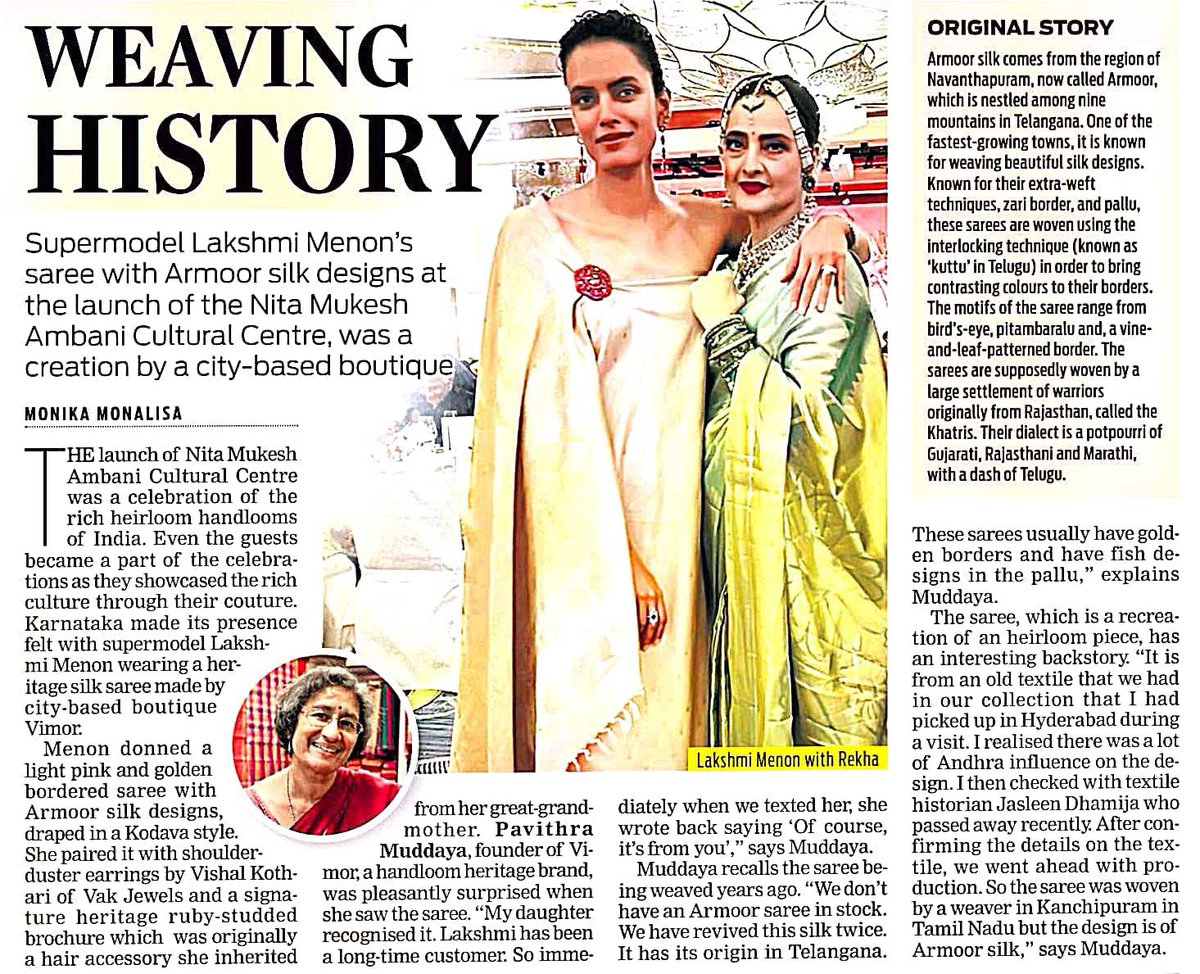The Armoor Silk Saree, a remarkable textile craft from Telangana, is an exquisite embodiment of India’s rich cultural heritage and craftsmanship. These sarees, primarily produced in the Armoor town of the Nizamabad district, have transcended their regional origins to captivate saree enthusiasts worldwide. Celebrated for their intricate designs, vibrant colors, and luxurious texture, Armoor Silk Sarees are a testament to the timeless appeal of traditional Indian textiles.
Historical Context
Origins of Armoor Silk
Armoor, surrounded by nine hills, has a vibrant history of silk weaving, largely attributed to the Khatri community, who migrated from Rajasthan. This community brought a confluence of artistic influences, including elements from Gujarati, Rajasthani, and Marathi cultures, interwoven with local Telugu traditions. Their dialect, a unique blend, reflects this cultural mosaic, mirrored in the distinctive patterns of the Armoor Silk Saree.
The intricate weaving techniques and motifs have been passed down through generations, each adding layers of richness to the saree’s heritage. Historical records suggest that the town’s strategic location on trade routes contributed to the fusion of styles, as merchants and travelers brought new ideas and materials.
Evolution of the Craft
Initially crafted for local use, Armoor Silk Sarees were predominantly worn during regional festivals and ceremonies. Over time, these sarees began incorporating design influences from neighboring regions, showcasing a harmonious blend of traditional and contemporary styles. This evolution was significantly influenced by interactions with other regional silk-weaving communities, thereby enriching Armoor silk with a myriad of design and material innovations.
The sarees are not only valued for their aesthetic beauty but also for their representation of the region’s history and social fabric. For example, motifs often tell stories or symbolize local folklore, making each saree a narrative piece.
Unique Features of Armoor Silk Saree
Weaving Techniques
The Armoor Silk Saree is renowned for its intricate weaving techniques. The ‘kuttu’ interlocking method is particularly notable for its ability to incorporate contrasting colors and motifs seamlessly. This method is labor-intensive and requires exceptional craftsmanship, with a single saree taking up to two weeks to complete.
Artisans employ traditional looms and techniques that have been used for centuries, ensuring each saree is unique. The use of natural dyes and high-quality silk further enhances the fabric’s luster and durability.
Design Elements
The saree’s allure lies in its elaborate motifs and designs. Common motifs include the fish, symbolizing prosperity and good luck, and bird patterns, representing freedom and joy. The pallu (the loose end of the saree) often features a cascade of these motifs, bordered with zari (gold or silver thread) that adds a touch of opulence.
The detailing in these sarees is a result of meticulous planning and execution. For instance, a saree might feature a complex pattern with thousands of individual threads, each contributing to the overall design. The precision required for such detailing is a testament to the weavers’ skill and dedication.
Color Palette
Armoor Silk Sarees traditionally sport a vibrant color palette, with reds, blues, and greens dominating the spectrum. These colors are not just visually appealing but are also symbolic, often chosen to reflect various emotions and occasions. The dyes used are typically natural, derived from local plants and minerals, which contribute to the saree’s eco-friendliness.
Cultural Significance
Representation of Telangana’s Heritage
These sarees are a vital part of Telangana’s cultural tapestry, often worn during significant festivals and weddings. They serve as a medium to showcase the state’s artistic prowess and cultural depth, making them a cherished heirloom for many families. The saree’s popularity has also led to the establishment of various craft villages in the region, where tourists can witness the weaving process and purchase authentic products.
Global Recognition
In a bid to preserve these cultural gems, UNESCO has listed Armoor Silk Sarees among the iconic textile crafts of India. This recognition not only honors the artisans but also amplifies the saree’s global appeal, attracting a wider audience and fostering a renewed appreciation for traditional Indian textiles. This global recognition has also opened new markets for the sarees, boosting the local economy and providing livelihoods for thousands of weavers.
Contemporary Relevance
Revival Efforts
The government and private entities have launched several initiatives to revitalize the Armoor Silk industry. Efforts include providing financial support to artisans, organizing handloom exhibitions, and introducing contemporary designs to appeal to younger generations. The Handloom and Textiles Department of Telangana has been actively promoting these sarees through various marketing initiatives, helping to connect artisans with buyers directly.
Additionally, collaborations with fashion designers have introduced Armoor Silk to new audiences, integrating traditional motifs into modern fashion trends. These efforts have significantly contributed to a resurgence of interest in these sarees.
Fashion and Beyond
Armoor Silk Sarees have graced the ramps of major fashion shows, with designers incorporating traditional motifs into modern silhouettes. Celebrities have also played a crucial role in popularizing these sarees, wearing them at international events and photo shoots, thereby bridging the gap between tradition and contemporary fashion.
Challenges and Opportunities
Threats to Traditional Weaving
Despite the resurgence, the Armoor Silk industry faces challenges from mass-produced textiles. The weavers, often struggling to compete with machine-made products, face dwindling income and uncertain livelihoods. There is also a risk of losing intricate weaving techniques as younger generations opt for more lucrative professions.
Pathways to Sustainability
To ensure the sustainability of Armoor Silk Sarees, there is a need for innovative approaches that blend tradition with modernity. Eco-friendly practices in silk production and diversification of product lines, such as integrating Armoor silk motifs into accessories, can provide new revenue streams and preserve the art form. Educational programs aimed at young people can also help pass down the craft, ensuring its survival for future generations.

